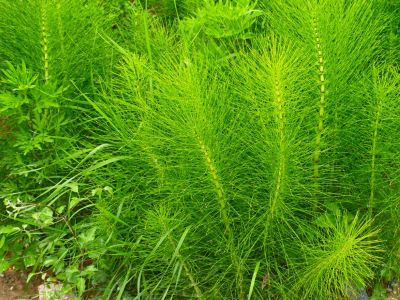Horsetail Plant Info
To some people it is a nuisance; to others it is an interesting and ancient herb that has earned its rightful place in history, the medicine closet, and beauty products. Growing where other plants dare not, horsetail plant is a member of the Equisetum family and is closely related to ferns. Like ferns, horsetail plants reproduce via spores and they have a very deep rhizome system that can tunnel up to 3 feet (1 m.) under the soil. Within the Equisetum family, there are two large groups: horsetails and scouring rushes. Horsetails have branches and a bushy appearance and scouring rushes have no branches. Both plants are without true leaves and use chlorophyll in their stems for photosynthesis. Horsetail is also known by a number of other names, including mare’s tail, horse pipes, snake grass, and joint grass. Horsetail plant info suggests that it has earned its name for its jointed or segmented appearance and bristle-like texture, which is similar to a horse’s tail.
Horsetail Herb Uses
Horsetail is a very valuable herb due to its high content of silicon used in the treatment of osteoporosis. Horsetail has also been used to lower blood pressure, as a diuretic, to strengthen brittle nails, stop bleeding gums, relieve sore throats, and as a topical treatment of burns and wounds. As with any herb, it is always best to consult a professional first. It can also be used as a substitute for a scouring pad in the kitchen by bundling several stems together and taking advantage of the tough and rough texture on the stems.
How to Grow Horsetail
Horsetail herb growing isn’t difficult if you provide the right conditions. Horsetail is fond of wet or boggy areas and thrives in poor soil, making it a perfect choice for areas in the landscape where other plants fail to thrive. Because it tends to spread rapidly, it’s best to give horsetail plenty of room to spread. The plants can also be kept in bounds by sinking them in bottomless containers. In fact, if you have limited space, you can grow horsetail in a container. Plants prefer a half day of sun and high heat and humidity. If you live in USDA plant hardiness zones 7 – 10, horsetail is easy to grow. It’s best to start plants from seed six weeks before the last frost and transplant outside in early spring. Caring for horsetail is easy once planted. Soil should remain wet at all times. If you are growing in a container, keep an eye on moisture levels and water accordingly. Keep old stems pruned for best performance.
Harvesting Horsetail Herbs
Horsetail herb harvesting is done in the summer. Pick stems, discarding any discolored ones, and let them dry in a cool, dark place. Once dry, the stem can be ground into a powder and stored in an airtight container for up to one year or used for ornamental purposes. Young shoots can also be eaten like asparagus.
